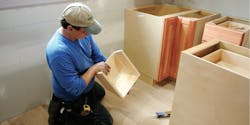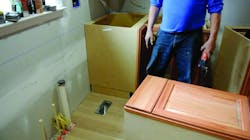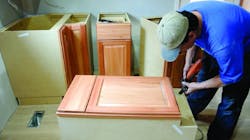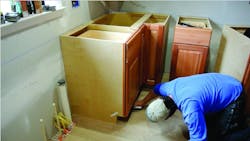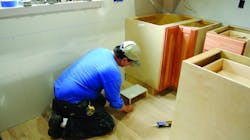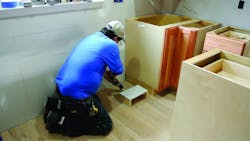HVAC registers are typically placed on outside walls, often under windows. This is problematic in a kitchen, where cabinets frequently occupy all of the exterior wall space. If floor registers are placed in front of cabinets, food and liquids can spill in, decompose, and contaminate air quality. And floor registers are underfoot for people working at the counter.
The most common solution is to bring the metal ductwork into the toe space. With the register mounted on the vertical face of the toekick, you can use a sharp 90-degree bend in the ductwork to direct air flow into the room. But it’s difficult to seal a metal duct to the wood cabinet, so some conditioned air is diverted into the toe space.
Jim Yingling, superintendent for Mark IV Builders, in Cabin John, Md., has come up with a solution: a simple custom-made toekick deflector. Fabricated from plywood scraps, the deflector can be easily sealed to both the subfloor and the cabinet, ensuring that all of the conditioned air from the concealed duct is directed into the kitchen.
The deflector has three sides and a lid and can be built on site from 1/8 inch or thicker plywood. Two sides are vertical and are cut at a 45-degree angle so they come to a point at the back of the duct opening in the floor. The third side sits on these angled edges and meets the lid. Glue the pieces together so that the box is sealed against air leaks. The inside dimension of the deflector where it meets the toekick should be sized to accept the finish register.
1. Measure to locate the ductwork in the floor, then transfer dimensions to the cabinet. Seal the metal duct to the flooring.
2. Draw an outline of the register opening in the face of the toe-kick and use a multi-tool to cut the hole. The hole should be just a little larger than the plywood deflector. This ensures that the front edge of the deflector can be sealed where it butts into the back of the toe-kick.
3. With the cabinet temporarily positioned, reach through the freshly cut register opening and mark a line on the floor along the back edge of the toe-kick. This line will be used to position the deflector.
4. Remove the cabinet and position the deflector over the opening by aligning the front edge with the line scribed on the floor.
5. If you choose not to apply construction adhesive or caulk to the edges before fastening the deflector to the floor, seal the edges afterward. When it’s time to set the cabinet, a bead of caulk along the front edges of the deflector will ensure an airtight seal to the toe-kick.
Adapted from a video at ProTradeCraft.com
